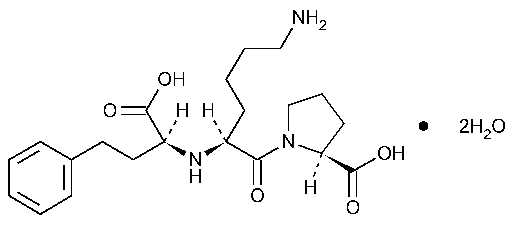Lisinopril
L-Proline,1-[N2-(1-carboxy-3-phenylpropyl)-L-lysyl]-,dihydrate,(S)-.
1-[N2-[(S)-1-Carboxy-3-phenylpropyl]-L-lysyl]-L-proline dihydrate [83915-83-7].
»Lisinopril contains not less than 98.0percent and not more than 102.0percent of C21H31N3O5,calculated on the anhydrous basis.
Packaging and storage—
Preserve in well-closed containers.
Identification—
A:
Infrared Absorption á197Mñ.
B:
The retention time of the major peak in the chromatogram of the Assay preparationcorresponds to that of the Standard preparationobtained as directed in the Assay.
Specific rotation á781Sñ:
between -115.3 and -122.5
and -122.5 (l=405nm).
(l=405nm).
Test solution:
10mg per mL,in 0.25Mzinc acetate.Prepare the 0.25Mzinc acetate solution as follows.Mix 600mLof water with 150mLof glacial acetic acid and 54.9g of zinc acetate,and stir to dissolve the zinc acetate.While stirring,add 150mLof ammonium hydroxide,cool to room temperature,and adjust with ammonium hydroxide to a pHof 6.4.Transfer the solution to a 1000-mLvolumetric flask,dilute with water to volume,and mix.
Water,Method Iá921ñ:
between 8.0%and 9.5%.
Residue on ignition á281ñ:
not more than 0.1%.
Heavy metals,Method IIá231ñ:
0.001%.
Assay—
Phosphate solution—
Dissolve 2.76g of monobasic sodium phosphate in about 900mLof water in a 1000-mLvolumetric flask,and adjust with 1Nsodium hydroxide to a pHof 5.0.Dilute with water to volume,and mix.
Mobile phase—
Prepare a filtered and degassed mixture of Phosphate solutionand acetonitrile (96:4).Make adjustments if necessary (see System Suitabilityunder Chromatography á621ñ).
Standard preparation—
Dissolve an accurately weighed quantity of USP Lisinopril RSin water,and dilute quantitatively,and stepwise if necessary,with water to obtain a solution having a known concentration of about 0.3mg per mL.
Assay preparation—
Transfer about 30mg of Lisinopril,accurately weighed,to a 100-mLvolumetric flask,dissolve in water,dilute with water to volume,and mix.
Chromatographic system
(see Chromatography á621ñ)—The liquid chromatograph is equipped with a 210-nm detector and a 4.6-mm ×25-cm column that contains 5-µm packing L7and is maintained at a temperature of 50 .The flow rate is about 1mLper minute.Chromatograph the Standard preparation,and record the peak responses as directed under Procedure:the column efficiency determined from the analyte peak is not less than 180theoretical plates,the tailing factor for the analyte peak is not more than 1.7,and the relative standard deviation for replicate injections is not more than 1.0%.
.The flow rate is about 1mLper minute.Chromatograph the Standard preparation,and record the peak responses as directed under Procedure:the column efficiency determined from the analyte peak is not less than 180theoretical plates,the tailing factor for the analyte peak is not more than 1.7,and the relative standard deviation for replicate injections is not more than 1.0%.
Procedure—
Separately inject equal volumes (about 20µL)of the Standard preparationand the Assay preparationinto the chromatograph,record the chromatograms,and measure the responses for the major peaks.Calculate the quantity,in mg,of C21H31N3O5in the portion of Lisinopril taken by the formula:
100C(rU/rS),
in which Cis the concentration,in mg per mL,of USP Lisinopril RSin the Standard preparation,calculated on the anhydrous basis,and rUand rSare the lisinopril peak responses obtained from the Assay preparationand the Standard preparation,respectively.
Auxiliary Information—
Staff Liaison:Andrzej Wilk,Ph.D.,Senior Scientific Associate
Expert Committee:(PA5)Pharmaceutical Analysis 5
USP28–NF23Page 1139
Phone Number:1-301-816-8305
